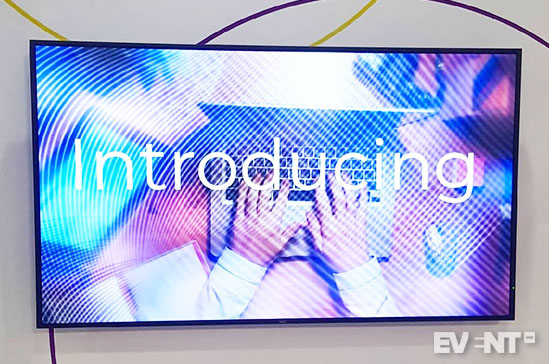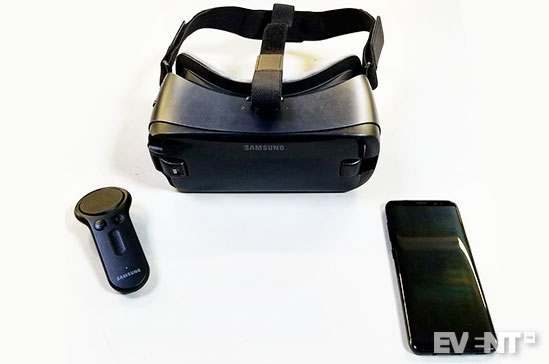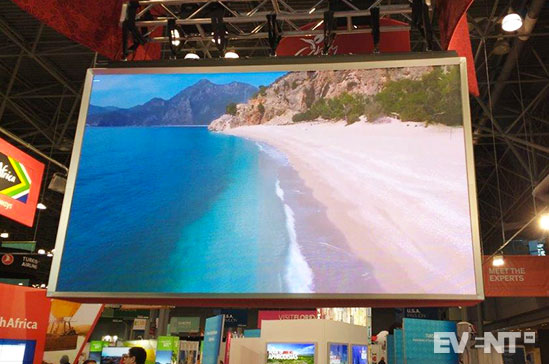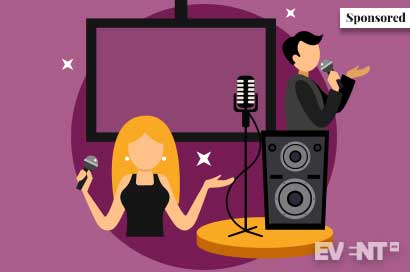This is a case study sponsored by Aria AV. More information about Event Manager Blog’s sponsored posts.
When it comes to technology, the landscape is always shifting. Today’s hot gadget can be tomorrow’s e-waste, and if you’re not paying attention, things can pass you by. That being said, it’s sometimes easy to get distracted by the latest shiny object and forget to keep an eye on the basics.
So as we find ourselves on the cusp of another new year, let’s take a look at not only some of the flashy new tech headed our way, but also keep in mind the practical, day-to-day improvements in audiovisual technology, and how you can use it to add to your event.
Display Technology Takes Center Stage
Advancements in display technology are perfect examples of technology that’s simultaneously getting better incrementally year after year, as well as advancing in giant leaps. While projectors, LED walls, and flat-panel displays are getting cheaper, brighter, and higher resolution each year, what’s being done with that technology continues to blow minds.
Creative Projection Will Really “Wow” Event Attendees
We’ve talked before about getting creative with projection, but this trend continues to “wow” as we move into the new year. If you haven’t already, this is the year to bring projectors out of the breakouts and ballrooms, and into receptions, awards ceremonies, registration areas, and beyond. Artists and other creatives are taking high-powered projectors and pointing them at the sides of buildings, and we’re not talking about million-dollar “projection mapping.” As long as you’re projecting straight onto a relatively flat surface, there’s no special software or equipment required. We continue to maintain that PowerPoint, a bright projector, and a little creativity can add a “wow factor” to just about any event!
Holograms Have Really Arrived (Kinda)
Speaking of “wow factors,” hologram technology has continued to evolve as well, creating more and more realistic, 3-dimensional effects. It’s not really hologram tech (at least not how it’s being implemented in meetings and events), but the illusion is amazing. Since this kind of hologram illusion is based on projection technology, the advances in one have benefited the other. And as projectors get brighter and more efficient, the hologram effects can be done in brighter and brighter spaces, and much closer to the audiences. As the prices come down and the quality goes up, hologram effects are starting to become real alternatives to flying in keynote speakers from around the world, or for bringing virtual characters to life at a party or reception. Expect to continue to see planners taking advantage of this exciting technology!
LED Walls at Events Continue to Amaze
Just a few years ago, modular LED walls had quite a few quirks. They were almost painfully bright, and their low resolution made it difficult to use it for anything other than patterns and colors in a stage backdrop. Well, if you haven’t thought about using the technology since then, you should definitely give it another look. The control systems now allow for extremely fine brightness control, the panels link seamlessly together, and the “dots per inch” have gone way up. All of this means that you can create displays of almost any size, in ridiculously high-resolution, allowing for beautifully detailed images and text, without it looking like something out of Minecraft. As the modules have gotten thinner, you can now create subtle (and sometimes not-so-subtle!) curves in the display, creating unique and dramatic looks.


Flat-Screen Displays Will Be Event Staples
Flat-screen televisions have never been more popular, and with significant reductions in both price and weight, planners are able to use them in more and more creative ways. In smaller breakout rooms, consider using one or more flat-screen displays instead of a traditional projector setup, especially in those with low ceilings. Consider putting a couple of smaller displays mounted on stands near the rear of the rooms, providing a closer look at the presentations for those who got stuck in the back.
Flat-screen displays can be used in a variety of interesting and useful ways, and in areas where projection can’t or won’t work due to not having a clear angle or people walking in front of the display. Think: hallways, registration areas — even mounted in bar facades or lecterns. And as touch technology continues to advance, they’re great for developing interactive kiosks and other attendee-facing portals.
Next-Gen Displays Are Coming to Events
As flat-screen technology has evolved, it’s gotten thinner, lighter, and more flexible. Driven mainly by the cell phone industry, this has started to create new opportunities for creative manufacturers, looking to diversify and sell to new industries. Look for thin, lightweight LCD and OLED displays to be integrated into everything as we move forward into the new year, including awards, gift bags and boxes, centerpieces, and so much more. Just a battery and a small programmable microchip can run these displays for hours, rotating branding or sponsorship for the entire evening.
And though it might not be ready for 2019, look for all of these technologies to converge into thin, lightweight LCD/OLED display panels that can be linked together like LED wall, but thin and flexible like cell phone displays. Basically, you’ll be able to “wrap” almost anything in display, creating dynamic and eye-popping decor.


Creative Lighting Becomes a Powerful and Accessible Tool for Event Planners
Perhaps one of the more interesting trends of the new year seems to be a renewed respect for the power of lighting to set the tone of the event. It’s an old technique, but new technology is bringing a renewed focus on how we can use lighting in interesting and dramatic ways. Frequently lower down the AV priority list behind projection and audio, savvy planners are starting to prioritize lighting, and embracing it in both subtle and wildly theatrical ways.
Set the Mood with Simple Event Lighting Touches
Lighting is by far one of the most cost-effective bangs for your buck. While seeing and hearing your speakers is doubtlessly important, so is affecting how your attendees feel. It doesn’t take much. Just adding a dash of color from an uplight in each corner, or a little splash of light on a stage backdrop can go a long way toward setting the tone of your event.
Like a lot of the rest of the technology we’ve highlighted, in the past lighting equipment has had a slow and steady march forward, coming down in cost, in power consumption, and increasing in versatility and brightness. However, nobody was prepared for the explosion of versatility and types of lighting available that came with the coming of age of LED bulb technology.
LED Lighting Delivers a Whole New World of Color
While most technology comes down in cost over time, LED lighting is leading the charge, and has never been cheaper and easier to find. Professional models can still cost a pretty penny, as extra time and effort have gone into things like color accuracy and reliability. LED lekos and PARs are ready for prime time and ready to replace their older, incandescent versions. These new instruments allow lighting designers to subtly tune the color and brightness of their stage lighting, without having to climb up on a ladder to change out the gel.
Beyond these high-end brand-name stage lights, however, the market has been flooded with inexpensive LED lighting. While they’re not able to fine tune the color as much, they are capable of shining the majority of colors used in events and are perfect for less “mission critical” highlights and decor like perimeter uplighting. Due to their lower power needs, and to advances in battery technology, these instruments are becoming highly portable, allowing you to take your lighting quite literally to the next level. Lighting the trees? How about lighting in the trees? No outlets? No problem.
Event Decor Gets Easy New Accents
One of the byproducts of developing flat-screen technology, manufacturers are now able to easily and cheaply produce flexible strips of LEDs. These can be mounted in and around almost anything, allowing furniture and decor providers to add a splash of color or light in unexpected places. Backbars, room dividers, you name it — they can be built into almost anything.
String lights are back in both big and little ways. “Cafe lights” (those strings of exposed light bulbs) are seeing a renaissance as their LED versions look like classic filament bulbs, with the benefit of being both lower power and significantly less breakable, making them easier to put up and take down. Mini lights have left the Christmas tree and gone micro, with thin-filament wires and tiny integrated, remote-controlled 3-color LEDs, all running off of battery (or even USB!) power. Drop them in a mason jar or glass lantern for a beautiful firefly light centerpiece that lasts all night long.


DIY Lighting Can Be Done on a Budget
Much like professional LED lights, consumer lighting products are adding more and more features while still coming down in price. Color-changing household bulbs, previously upwards of $30 each, are now down below $10 and controllable from your smartphone. Screw them into some off-the-shelf home decor uplight units, and you can put together a pretty nice color-changing DIY lighting package for under a couple hundred bucks. Just pay attention as to whether or not they require a hub, and make sure you know how to get them on the venue WiFi network (or plan on bringing one of your own).
AR and VR Deliver Unparalleled Experiences and Process Improvements
While VR (virtual reality) and AR (augmented reality) products leapt onto the scene with a bang, early products such as the Oculus Rift and Google Glass only caught fire with enthusiasts. Now it’s several years later, and every major technology company is trying to get a piece of the market. Sony, Facebook, Google, Microsoft and Samsung are the usual suspects, but some smaller brands like HTC and Magic Leap are poised to become giants in their own right.
Huge purchases of the technology by large corporations and the military are going to bring a major boost to the lines this year, so expect some big advancements in quality, as well as in style and battery power.
Standalone VR Experiences Alleviate Participation Barriers
When most people think of Virtual Reality in events, this is usually what they’re thinking of: a standalone experience in the corner that people can line up for and take part in, along the lines of a photo booth or other “party activity.” With the advances coming down the line, this will definitely continue to be a draw, and the games and other immersive experiences currently in development are going to blow people’s minds. Even people who tend to feel a bit queasy wearing the headsets might want to give it another try as improvements in resolution and framerate are significantly reducing this issue for most people.


Blending the Real and the Digital Becomes Easier
Don’t make the mistake of thinking that VR is just a game relegated to the corner, though. Entire event spaces are being built with modular walls that can be moved and rearranged so that wearers of virtual reality headsets can walk around in their virtual reality environments and still have the tactile feeling of walls, buttons, hallways, doors, hatches and vents. All of the real world items are mapped and skinned in the virtual ones, so walls that are just plain white in the room become dirty, grungy lab walls in the virtual environment. The experience can be powerfully real, however, and may prove to be too intense for some attendees! That’s OK, thanks to cameras in the room, and big screen displays of what the participants can see, you can still feel like you’re part of the action while you sip a drink in the lounge!


AR Is Growing Up
Unlike virtual reality, in which the group is dropped into a virtual environment, augmented reality layers graphics and other information over your own. Most of the development in this area has surrounded advertising, in which you point your phone at a publication or poster and it magically comes to life. And beyond a few breakout hits like Pokemon Go, that’s been most of the focus.
That’s all about to change as Microsoft Hololens continues to develop, and Magic Leap releases it’s new AR headset. These devices are able to layer amazingly realistic graphics over what are essentially clear lenses. This creates a different kind of mixed reality, but one where the guest can still fully see the real world, and game elements are layered on top of it. The wall of the venue may appear to break open as robot spiders crawl out and over the real-world furniture in the room, or on a less frightening note, a virtual plant that grows out of the screen the more correct answers the group has in a charity trivia contest.
VR/AR Solve Problems for Event Site Visits and Beyond
There’s one more VR/AR trend to look for next year, and that’s applications for venues and planners. We’ve already started to see the first virtual site visits, but a lot of these are not much more than 360° photos or videos. Some companies are now starting to combine full 3D renderings of venues with options for configuring virtual seating charts. This allows the planner to do a full 3D walkthrough of the space, fully equipped with tables, chairs and basic staging. As more and more models are added to these systems, their ability to replicate exactly how your event will look will only get better!
Bonus 2019 AV Trend for Events
AI-Powered Everything at Events
Be prepared. If you thought every sales pitch in 2018 seemed to include artificial intelligence (AI), just wait for next year. Amazon, Google, and Microsoft have made AI available to the masses, and pretty much every website, app, or other digital service is playing with it. Try not to get overwhelmed by the hype, and stick to your goals. Make sure you’re asking your providers for real-world examples of how their services are going to benefit you and your attendees by adding in AI.
IN CONCLUSION
In a lot of ways, 2019 will be a more iterative year. We don’t anticipate any big, new “wow” technologies to emerge, but you never know. Meanwhile, current technologies continue to keep plugging along, but with significant improvements. If you haven’t looked at a technology in a while, it might be a good year to revisit it. Keep an eye on the basics, and how these ever-advancing technologies can improve your events!






